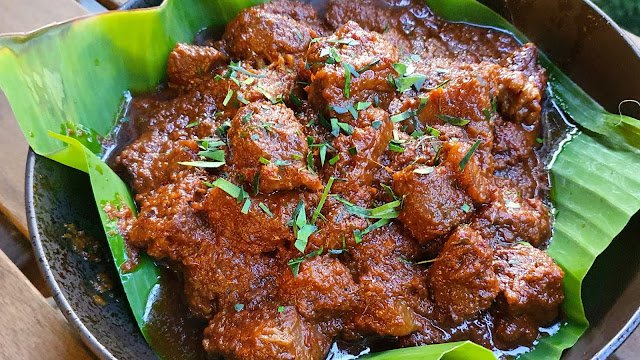I love Beef Rendan. I love Beef Rendan.
As I said in my previous book and in my cookbook, Rendan Wei, where local beef is cooked, turns it into a very special dish. The humble to sublime, slow-stewed beef Rendan is a French beef bourguignon.
I recently made a batch. There, some diners felt it was “the best I’ve ever had.” I don’t want to bet my version of claims as I think I’ve had a very good Rendan in the past. You can think of the version of my mother I grew up in. I couldn’t cook the exact same version as her and she used local Malaysian beef. I also like the version cooked by Penang Place.
Certainly there are many varieties of Rendan, and you should have an open mind to taste the many varieties there. From my own experience, the following tips can help:
Cooking a good render is not something you can do in a hurry. Be prepared to go for up to 3 hours. Traditional boiling in woks is still the best and I’m not happy with the version that tried to reduce the time required by applying pressure. Like all good curry, including onion paste, the long simplicity gives it a mellow taste. As for beef cuts, I prefer those who have a thread-like meat texture and you’ll get it on topside or brisket. It is important to add sour (assam kepine or tamarind juice). White sugar can be used, but gra melaka or Indonesian palm sugar gives it a more complicated flavor. It’s difficult to explain, but the sauce has a more caramelized feel and taste. Chili peppers give them a smoky taste, so you should use them. In my opinion, blue inger is essential for Rendan, but note that it makes the sauce too little overwhelming. As for the lemon grass, it can be added and removed later, but I prefer to blend it into the sauce for an additional texture.
Either way, this blog is my cooking notes, as my wife says very often. Write down the recipe.
And it’s here. Note that a few years ago I blogged a recipe for Rendan here.
material
2 kg of upper or brisket in a cube up to about 2-3 cm wide
Blend Paste
500gm red onion
100gm garlic
1 inch blue inger
Three stems of lemongrass
4 tablespoons of dry red chilly paste
300 ml of cooking oil
200 GM Gula Melaka or Palm Sugar
1 tablespoon of table salt
2 Assam Gelgar (dried tamarind slices)
1 pack of kara coconut milk (200 ml)
2 tsp Kerisik (dried coconut)
Some of the kaffir lime leaves
Some water if necessary
Heat the oil in a wok. Add the blended paste, Assam Keeping, palm sugar and palm sugar and simmer for 30 minutes, stirring occasionally. Mix the beef cubes and stir. Add coconut milk and kelisik. Simmer low until the beef is tender and easily tears. The duration depends on the type of beef cutting and the type of wok or pot you are complaining about. If the sauce is too dry, add some water occasionally. Stitch the edges and garnish with diced caffear lime leaves.
It is important to taste the sauce while cooking to adjust it. To add notes, sometimes I add cumin and coriander seeds and there are other opportunities to blend in with turmeric leaves and femoral inger. These are variations that you can experiment with to get a different flavor in your sauce. As for Kerisik, it’s best to do it yourself, but I have to add that I sometimes use store-bought versions. Toast the coconut meat in a wok and stir constantly for about 30-40 minutes until it is light brown. After this, pounding with Lesson or using a good blender is to turn it into an oily paste. I had the beef lending version (without pouring it), which was only made with toasted coconut (but not pouring), and I think this would be acceptable too.
 The early stages of cooking in a wok.
The early stages of cooking in a wok.
 The early stages of cooking in a wok.
The early stages of cooking in a wok. 


